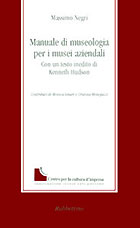Massimo
Negri
Manuale di museologia per i musei
aziendali
Review by Tommaso
Fanfani |

|
|
Enlarge text |
 |
 |
|
 More
and more companies are taking interest in the reorganization
and enhancement of their historical heritage. Companies
worldwide are increasingly aware that collecting,
preserving and organizing the records of their productive
activity is far from being a cultural trifle. In
fact, combining tangible values, such as business
and territory, with the intangible
but basic value of culture has
not only proven to be worthwhile, but also profitable.
More
and more companies are taking interest in the reorganization
and enhancement of their historical heritage. Companies
worldwide are increasingly aware that collecting,
preserving and organizing the records of their productive
activity is far from being a cultural trifle. In
fact, combining tangible values, such as business
and territory, with the intangible
but basic value of culture has
not only proven to be worthwhile, but also profitable.
Corporate social responsibility continues to gain
importance and is carried out through various activities:
sponsoring of events for solidarity, fund-raising,
social budgeting, transparency, and ethical rating.
Firms also express social responsibility through
a different relationship between company and clients,
business and stakeholders.
Companies are progressively mindful of a deep and
profitable links between enterprise and territory.
Enterprise is not only in charge of goods and services
production, but also plays a fundamental social
role, i.e. cultural promotion and preservation of:
  |
- |
 |
the historical
roots of its production process |
| |
- |
|
the territory |
| |
- |
|
the surrounding
community with its own culture, customs
and worldview.
|
To fully grasp the relationship between business
and territory, companies need to spearhead projects
for spaces that:
  |
- |
 |
house records of corporate/productive
activity |
| |
- |
|
host seminars, meetings
and discussions take place |
| |
- |
|
sponsor art exhibits or
other cultural events
|
The entrepreneur’s aim is to make a profit,
but also to combine its economic goals with the
intrinsic expectations of the local community.
Manuale di museologia per i musei aziendali,
written by Massimo
Negri with Monica Amari and Cristina Menegazzi,
presents an invaluable review of these assets, which
serves to define the broad range of corporate social
responsibility.
The book:
  |
- |
 |
sums up the literature
on company museums |
| |
- |
|
explains how a company
museum comes to life |
| |
- |
|
gives information about
company museums in Italy and abroad
|
| |
- |
|
lists the several kinds
of company museums that can be planned and
created with reference to different production
fields
|
| |
- |
|
sets out guidelines for
the best exploitation of resources allotted
to company museums or archives.
|
Manuale di museologia per i musei aziendali
lays out a cultural path, aimed partly at helping
professionals who are already working in the field
— with outlines, classifications etc.—
but also describes the dynamics of company museums
in order to suggest new reasons why a museum should
be created. There are also practical guidelines
and reference models, such as the museum in Velenje,
a mining district in Slovenia.
The authors take for nothing for granted with an
apparently simple and surely over-exploited topic
such as the general culture of museums. Problems
and proposed models start from the awareness
that each company has its own history to
share and potential to develop;
yet is firmly grounded in the local culture and
identity. In other words, enterprise helps to create
a community’s cultural identity that the museum
should then preserve and enhance. In fact, the company
museum acts as a powerful social tool
in the interest of both stakeholders and shareholders.
Although traditionally associated to the sphere
of culture, the company museum also has a significant
role as a vehicle for spreading a positive
corporate image, i.e. a marketing tool
aimed at shareholders’ satisfaction. The museum
is a «culture-carrier»
and an open workshop. Each museum’s
mission has to be defined, elaborated and declared.
It has several goals: social, cultural and commercial.
A company museum shows stability,
long-term creativity; and focuses
on human factors such as research and innovation
– values that raise brand visibility and thus,
its power on the market. By opening this public
channel, a company lets its skills, success
and longevity be judged, and increases
the value of its products through positive feedback
in terms of image and intangible worth.
The Piaggio
Museum is a case in point: it started as a collection
of written records intended to create an historical
archives. In 1992-1993, the project goals included:
  |
- |
 |
increasing the feeling
of belonging |
| |
- |
|
exhibiting the most important
products from 1884 until today |
| |
- |
|
tracing the commercial
development of the Liguria and Tuscany regions
|
| |
- |
|
sharing the Agnelli family
history
|
| |
- |
|
creating a cultural body
within the company
|
| |
- |
|
consolidating a cultural
links between business and the local community
|
Considering the basic issues that face a new relationship
between business, culture and the surrounding territory,
Giovanni Alberto Agnelli established an archives
and museum, as well as the Piaggio
Foundation to manage and promote the activities
of both. The foundation is jointly owned by public
and private bodies.
Piaggio’s cultural project is a fine example
of how to put Massimo Negri’s manual into
practice. Despite its name, there is little focus
on the brand. It is actually a district museum which
collects the memories and records of the whole territory;
a museum of science and technology; an open workshop;
a place where meetings, discussions and art exhibits
take place. In one word, it is a place where business
and territory meet and share the same values and
goals.
